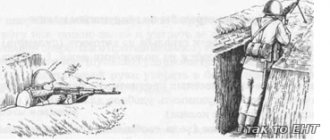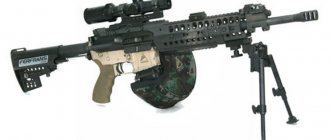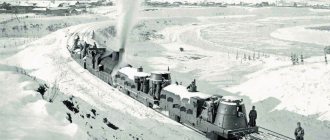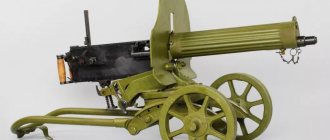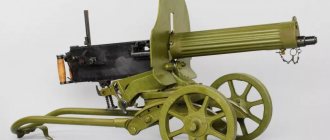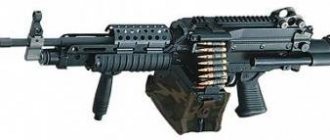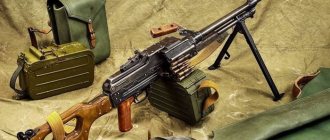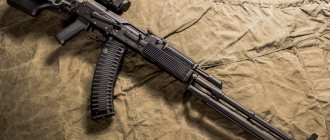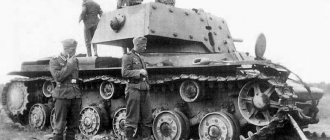Machine guns are a type of automatic small arms that have some characteristic features. Firstly, their main means of hitting targets is concentrated burst fire. Therefore, they need a large amount of ammunition and the ability to fire for a long time without overheating the barrel. Secondly, shooting from such weapons is usually carried out from a point-blank range.
Even if a machine gun is called a manual one, it is traditionally placed on a bipod for firing. Consider the main examples of such weapons created for arming infantry in Russia, the USA and Germany.
Russian machine guns
Soon after the end of the Great Patriotic War, the USSR adopted the Degtyarev RPD light machine gun, a light fire support weapon for the infantry squad. It used a newly developed 7.62mm intermediate cartridge and was fed from a metal strip. The RPD turned out to be a light and trouble-free weapon that has earned popularity around the world.
Despite the high combat qualities of the RPD, it had a serious drawback - the lack of unification with other types of infantry weapons. This led to the adoption of the Kalashnikov RPK light machine gun - in fact, just an AK with a longer heavy barrel. Unfortunately, belt feeding had to be abandoned, which reduced the combat capabilities of the weapon. However, the RPK is still in service with the Russian army, the latest modification is the RPK-16.
In 1970, the Soviet Union began to develop a large-caliber machine gun designed to replace the obsolete DShK.
As a result, the NSV “Utes” appeared. However, already during combat operation it became clear that the pursuit of weight reduction also brought negative results. Thus, the barrel resource was short, and to reduce recoil the machine had to be additionally pressed to the ground, for example, with sandbags.
The shortcomings of the Utes were corrected with the latest Russian heavy machine gun. At the same time, the KORD received not only a barrel with increased survivability and an effective muzzle brake. It became the first large-caliber automatic weapon that could be used as a manual weapon - from a bipod.
The main single machine gun of the Soviet army was the Kalashnikov PK system. This is one of the best examples in its class, but it has also been radically improved. "Pecheneg", created for the Russian armed forces on the basis of the PKM, has an original system of forced barrel cooling, which allows firing without overheating and replacing the barrel with a spare one.
Browning machine gun M1917, M1919A4, M1919A6 (USA)
Browning M1917A1 machine gun.
Browning M1917A1 machine gun on an M1917 tripod.
The Colt MG38 machine gun is an export “commercial” version of the Browning M1917, the thirties.
The Polish version of the Browning machine gun with cooled cooling is the Wz.1930 caliber 7.92x57 Mauser.
The Swedish version of the Browning machine gun with cooled cooling is the Ksp-36 caliber 8x63 anti-aircraft version.
Browning M1919A2 machine gun, created for the US cavalry after the First World War.
Browning M1919A4 machine gun on the M2 machine.
Browning M1919A4 machine gun.
Browning M1919A6 light machine gun.
Illustration of the differences in the design of the M1919A4 and M1919A6 machine guns.
The Belgian version of the Browning machine gun with an air-cooled barrel is the FN 30 machine gun of post-war (early 1950s) production.
Diagram of the locking assembly for the M1917 and M1919 Browning machine guns.
| M1917A1 | M1919A4 | M1919A6 | |
| Caliber | .30-06 / 7.62×63 | ||
| Weight | 14.8 kg machine gun body + 3.3 kg water + 24 kg M1917 machine | 14.1 kg machine gun body + 6.4 kg M2 machine | 14.7 kg with stock and bipod |
| Length | 981 mm | 1044 mm | 826 mm |
| Barrel length | 607 mm | 610 mm | 610 mm |
| Nutrition | tape, 250 rounds | ||
| Rate of fire | 450-600 rounds per minute | 400-500 rounds per minute | 400-500 rounds per minute |
In the United States, the problem of machine guns, which acutely arose with the country's entry into the First World War, was quickly and successfully solved by John Moses Browning in collaboration with the Colt company, in 1917 presenting his analogue of the Maxim machine gun, which, with similar characteristics, was distinguished by a greater simplicity of design. Already the very first prototype of a Browning machine gun with a water-cooled barrel set a kind of record, using 20 thousand rounds of ammunition in one test without a single breakdown. It is not surprising that by the end of the First World War, the production of these machine guns, designated M1917, went into tens of thousands. The very next year, on the basis of the M1917, Browning created the M1918 aviation machine gun with an air-cooled barrel, and a year later - the M1919 tank machine gun, also with air cooling. On the basis of the latter, Colt produces several models of “cavalry” machine guns on light machine guns, as well as export commercial samples for different calibers. In 1936, the M1917 machine gun, which at that time was the main machine gun for the US Army, underwent minor changes aimed at increasing its service life, but its main drawback - excessive weight (both the machine gun itself and the tripod machine) did not go away. Therefore, in 1940, a competition was announced for a new lightweight machine gun for the US Army. A significant part of the competitors were variations on the theme of Browning’s design, but there were also purely original systems. However, none of the samples fully satisfied the requirements of the military, and as a result, a variant of the Browning M1919 machine gun in the M1919A4 version, complete with a lightweight M2 tripod machine, was adopted. It was the M1919A4 machine gun that became the main weapon of the American troops during the Second World War and the Korean War. However, a significant number of earlier M1917A1 machine guns also actively participated in combat operations in all theaters of war. In 1941, the United States also announced a competition for a belt-fed light machine gun, in which several large corporations and government arsenals participated. It should be noted that the American military, like the Soviet military, also wanted too much from a light machine gun, and just like in the USSR, and as a result, the army had to be content with a palliative solution in the form of a modification of an existing machine gun. And since the US Army did not have a ready-made “normal” light machine gun, the Americans had to follow the path taken in other countries back in the First World War or immediately after it. This way was the creation of a lightweight “manual” version of the M1919A4 heavy machine gun, designated M1919A6. The result was a path and a reliable and relatively powerful, but very heavy and inconvenient weapon. In principle, special round boxes for a 100-round belt were developed for the M1919A6, attached to the machine gun, but in most cases the infantry used standard 200-round boxes with a belt, carried separately from the machine gun. Theoretically, this machine gun could be considered a single machine gun, since it made it possible to install it on a standard M2 machine gun (if the kit included a corresponding pin attached to the receiver), but in reality, the “big brother” M1919A4, which had more heavy barrel, etc. as a result, it provided greater capabilities for conducting intense fire. Interestingly, the Americans, apparently, were quite satisfied with the rate of fire of their machine guns, despite the fact that it was only a third of the rate of fire of the German MG 42 machine gun.
Variants of the Browning infantry machine guns were produced under license from Colt in Belgium at the FN plant and in Sweden at the Carl Gustaf plant, and without a license in Poland.
The M1917A1 machine gun is an automatic weapon with a water-cooled barrel. The machine gun was automatic using recoil energy and a short barrel stroke. The barrel was locked by a special wedge that moved in a vertical plane and, when raised, entered a cutout in the body of the bolt, rigidly interlocking the bolt and the barrel shank. After a short recoil, the locking wedge was lowered, releasing the bolt, after which, through a lever recoil accelerator, the recoil energy of the barrel was transferred to the bolt. Shooting was carried out from a closed bolt, with automatic fire only. The cartridges were fed from non-loose belts with a closed link (canvas), the belt was fed from right to left. The cartridge was removed from the tape when the bolt moved backwards using a special gripper-feeder, after which the cartridge was lowered so that its edge fell into the T-shaped groove on the bolt mirror, and then the cartridge was sent into the barrel. The spent cartridges were ejected downward through a cutout in the bottom of the receiver. Fire controls included a pistol grip on the buttplate of the receiver and a trigger. The main mounting for the M1917 machine gun was the M1917 infantry tripod mount. The cradle of the machine had mechanisms for aiming according to the terrain angle and horizon. The M1919A4 machine gun was structurally practically no different from the M1917A1 machine gun described above. The main difference was the use of a massive air-cooled barrel, enclosed in a perforated casing. A quick replacement of the barrel in combat conditions was not envisaged, since after each change of the barrel the machine gun needed to adjust the gap between the breech of the barrel and the bolt mirror. In addition, the machine gun received a new low-profile M2 machine gun, which had simplified (compared to the M1917 machine) guidance mechanisms and significantly less weight. The M1919A6 machine gun differed from the M1919A4 in having a lighter barrel of smaller diameter, as well as the presence of a massive removable folding bipod on the barrel casing and a removable butt attached to the pistol grip behind the receiver.
US machine guns
John Browning began developing a large-caliber machine gun to combat armored vehicles and aircraft in the last years of the First World War. In the early 20s, it began to enter the troops under the designation M1921. This model, with a water-cooled barrel, was produced until 1933.
That year, two variants were released simultaneously, under the same designation M2 - with an improved water cooling system, and a sample whose barrel was cooled by air. The air-cooled version turned out to be so successful that it is still in production.
In the early 40s, Melvin Johnson proactively developed a self-loading rifle of .30-06 caliber and its automatic version, suitable for use as a light machine gun. Before World War II, the United States did not accept them for service, and the weapons were not sent to the Dutch East Indies before the Japanese invasion.
As a result, the Johnsons were used to a limited extent by sabotage and reconnaissance detachments, since they were lighter than standard Browning automatic rifles.
The first attempt by the United States to create a single machine gun can hardly be called successful. American Saco M60 arr. 1957 proved to be unreliable and capricious, and its sight, bipod and gas outlet were attached to a replaceable barrel. However, it was produced unchanged until the early 80s.
In the 80s, as part of the modernization, the M60 received a new bipod, a modified barrel mount and a different gas outlet.
At the same time, reliability not only did not increase, but, it is believed, even fell. The shortcomings were finally overcome only in the M60E4 model, but by this time the United States had already adopted the Belgian model - FN MAG.
The designer of the M16 rifle, Eugene Stoner, developed the Stoner 63 modular rifle system in 5.56 mm caliber in the 60s. It also included a tape-fed sample. The system, which turned out to be quite capricious and demanding to maintain, was not accepted for service, but as part of military testing, Stoner’s weapons were actively used by US Navy special forces in Vietnam. These machine gunners were even given the nickname “Stonermen”.
In parallel with the Stoner system, light support weapons based on the AR-15 platform were being developed. The Colt CMG-2 version was offered for testing to special forces fighting in Vietnam, but to no avail. After this, development stopped.
Since the 80s, the Belgian Minimi (under the symbol M249) has become the main support weapon for the US armed forces branch. However, by the beginning of the 2000s, the power of the 5.56 mm cartridge no longer satisfied everyone - for example, special forces considered it insufficient. Existing 7.62 mm caliber samples were considered too heavy. As a result, the Mk.48 appeared - a variant of the M249 chambered for a 7.62x51 caliber rifle cartridge.
In the 2000s, the Americans began to develop a new light machine gun, which would be inferior in weight to the M249.
During the LSAT project, two variants of weapons were studied - with caseless cartridges and with ammunition in which the bullet is recessed in a plastic sleeve. It was expected that if successful, LSAT could be put into service as early as 2016. This did not happen - in 2018, a new program for the development of promising automatic weapons was launched.
American anti-aircraft machine guns
Since the advent of military airplanes, machine guns have become one of the most effective means of combating them.
At first these were standard infantry models, used from standard machine tools or homemade devices for anti-aircraft shooting. As the altitude and flight speed of combat aircraft increased, as well as their security, specially designed multi-barreled and large-caliber anti-aircraft machine gun mounts were adopted, into the ammunition of which armor-piercing incendiary and tracer incendiary cartridges were specially introduced to increase the efficiency of firing at air targets. This approach fully applied to American anti-aircraft machine guns created in the interwar period and during the Second World War. The first American machine gun used to fire at air targets was the Colt–Browning M1895. This weapon, designed by John Browning, was purchased by the US Navy in 1896. At the same time, the Navy used the 6 mm Lee Navy cartridge, and the Army used the 30-40 Krag cartridge. Subsequently, the machine gun was converted to accept 7.62x63 mm ammunition (30-06 Springfield).
American soldiers with a Colt–Browning M1895 machine gun
The machine gun went down in history as the first type of automatic weapon adopted for service, implementing the principle of removing powder gases. Thanks to the use of air cooling of the barrel, the machine gun turned out to be relatively light. The weight of the machine gun with a tripod was 45.5 kg. Feeding was carried out from a tarpaulin belt for 100 and 250 rounds. The rate of fire was 420-450 rounds/min.
Late version of the Colt–Browning M1895 machine gun
Due to the fact that the Colt–Browning M1895 machine gun had a relatively small mass, during the First World War it was used to arm combat aircraft. Back in 1910, the American Colonel Davidson attempted to create a self-propelled anti-aircraft gun by mounting two machine guns on the chassis of a Cadillac G passenger car capable of firing at air targets.
The installation was named Balloon Destroers. Two such vehicles were built, but the military department showed no interest in the project. Subsequently, some of the Colt–Browning M1895 machine guns were adapted for anti-aircraft shooting. To do this, they were installed on machines with an extended stand and equipped with anti-aircraft sights.
Italian soldiers with a Colt–Browning M1895 machine gun, adapted for anti-aircraft shooting
However, the Colt machine gun was never popular in the US Army. This was due to the fact that, due to design features, the weapon at the position had to be raised quite high above the ground. In addition, the air-cooled barrel quickly overheated, due to which the machine gun could not compete with the water-cooled Maxim. In this regard, by the end of the 1920s, the US armed forces abandoned the Colt–Browning M1895 machine gun.
The Browning M1917 machine gun, adopted for service shortly before the end of the First World War, became much more widespread in the American army. This weapon, chambered for 7.62x63 mm, created by John Browning in collaboration with Colt, was an analogue of the Maxim machine gun, but had a simpler design.
Browning M1917 machine gun
In general, this machine gun fully satisfied the requirements for it in terms of efficiency and reliability. At the end of the 1930s, based on operating experience, the machine gun was modernized, after which it received the designation M1917A1. In 1926, the production of machine guns with a sight began, which allowed effective shooting at both ground and air targets. The standard tripod provided a vertical aiming angle sufficient for anti-aircraft firing.
The weight of the machine gun in the firing position on the machine was 47 kg. Belt capacity – 250 rounds. Rate of fire – 600 rounds/min. Thanks to water cooling, the M1917A1 could fire intensely for a long time. In addition to the infantry tripod, machine guns were mounted on armored vehicles and on anti-aircraft turrets. During the war, as part of the provision of military assistance, M1917A1s were supplied to the allies of the anti-Hitler coalition and were used throughout the war, including as anti-aircraft ones.
Browning M1917A1 machine gun in anti-aircraft firing position
Due to the fact that the American army during World War II fought almost all the time under the umbrella of fighter cover, and the air defense units had 12.7 mm machine guns, 37-40 mm anti-aircraft guns and 90 mm anti-aircraft guns in sufficient quantities guns and Browning M1917A1 infantry machine guns did not play a decisive role in the fight against the air enemy. However, this machine gun was widely used in the armed forces of the United States and allied countries, and therefore machine gun crews probably have shot down German, Italian and Japanese combat aircraft.
As mentioned earlier, the Browning M1917A1 machine gun was very reliable and, thanks to the water-cooled barrel, could conduct intense fire for quite a long time. But after the end of the First World War, it became clear that this machine gun did not meet modern requirements in terms of the ability to be carried over long distances and mobility on the battlefield. As a result, a modification of the Browning M1919 machine gun in the M1919A4 version with a lightweight M2 tripod machine gun was adopted. It was this machine gun that became the main weapon of American troops during the Second World War. The M1919A4 machine gun, which was relatively lightweight, served in the infantry as a company and battalion fire support weapon that established itself as a highly reliable weapon.
Browning M1919A4 machine gun on the M2 machine
The main difference between the M1919A4 and the M1917A1 was the use of a massive air-cooled barrel enclosed in a perforated casing. A quick replacement of the barrel in combat conditions was not envisaged, since after each change of the barrel the machine gun needed to adjust the gap between the breech of the barrel and the bolt mirror. In addition, the machine gun received a new low-profile M2 machine gun, which had simplified (compared to the M1917 machine) guidance mechanisms and significantly less weight. The weight of the Browning М1919А4 machine gun together with the machine was 20.5 kg. Rate of fire – 400-450 rounds/min. Food was supplied from a 250-round belt.
Although the standard M2 infantry machine gun did not allow firing at large elevation angles, the M1919A4 machine gun was very often used as an anti-aircraft machine gun, for which it was mounted on various turrets and specially created machines. Anti-aircraft machine guns of this type were standardly equipped with many American tanks and armored vehicles.
The machine gun was also often carried by Willys MB light cross-country vehicles. Such vehicles with machine gun armament were used for reconnaissance and patrol service, escorting transport convoys, guarding headquarters and important rear facilities. The machine gun, mounted on a swivel with equal convenience, could be used to fire at ground and air targets.
After the end of World War II, the M1919A4 machine gun became very widespread, and in a number of countries, despite its advanced age, it is still in use.
Although American heavy machine guns chambered for a rifle cartridge generally met international standards, in the second half of the 1930s it became clear that to effectively combat front-line bombers and attack aircraft, larger caliber weapons were required. The use of metal in the design of aircraft, the protection of fuel tanks and pressurization of them with neutral gas, as well as the introduction of bulletproof glass and other elements of armor protection led to the fact that the damaging effect of rifle-caliber bullets when firing at combat aircraft was sharply reduced. In addition, it was highly desirable to increase the effective firing range against fast-moving air targets. As is known, for machine guns firing rifle cartridges, this figure did not exceed 500 m.
In this regard, in a number of countries in the pre-war period, machine guns of 12.7-15 mm caliber were created. In the United States, the niche of large-caliber machine guns designed to combat light armored vehicles, aircraft, manpower and destroy light field fortifications was occupied by the very successful 12.7-mm Browning .50 Caliber Machine Gun, better known under the designation Browning M2.
Browning M1921 anti-aircraft machine gun
This weapon was created in 1932 based on the 12.7 mm Browning M1921 machine gun. In turn, the design of the large-caliber M1921 was largely the same as the M1917, which used rifle-caliber cartridges. The new 12.7 mm ammunition was also obtained by proportionally increasing the American 7.62 mm rifle cartridge to the Springfield M1903 rifle. This, in essence, mobilization technical solution turned out to be unusually successful.
The 12.7x99 mm cartridge, also known as the 50 BMG, had almost twice the effective fire range of the 7.62x63 mm rifle cartridge. The M1 armor-piercing bullet weighing 48.6 g had an initial speed of 808 m/s and at a distance of 500 m, when hit at a right angle, could penetrate a 16-mm armor plate.
However, in the 1920s, the command of the American army did not see the need for a multi-purpose heavy machine gun, and for this reason, production of the Browning M1921A1 modification was started only in 1930.
The machine gun was mounted on a tripod machine. Thanks to water cooling, it could fire for quite a long time with a rate of fire of 550-600 rounds/min. The weight of the machine gun on the machine was 54.8 kg, and before firing the casing must be filled with water, which did not make the weapon lighter. The heavy machine gun's accessory kit included a manual water pump for pumping coolant in the casing.
However, the M1921A1 machine gun received recognition in the Army and Navy and was produced in single and coaxial versions. 12.7 mm machine guns were used on tripod field machines and pedestal mounts. In 1933, the 12.7 mm machine gun was modernized and a modification with an air-cooled barrel appeared.
A water-cooled machine gun was used mainly to combat enemy aircraft, while an air-cooled machine gun was used as a universal one.
Water-cooled anti-aircraft guns were a fairly powerful means of close-range air defense. However, the use of this effective anti-aircraft weapon in a portable version was difficult due to its excessive weight.
The water-cooled M46 coaxial machine gun mount was widely used on the decks of warships and coastal defense facilities. To prevent boiling of the coolant during prolonged shooting, a hand pump was provided for each barrel, connected to the casing by reinforced hoses.
Subsequently, in order to prevent overheating, a barrel with thicker walls was developed for the infantry version, so the infantry machine gun was designated Browning Machine Gun, Cal. .50, M2HB, Flexible - Browning machine gun 0.5 inch caliber, model M2HB with a heavy barrel, or M2HB for short. In 1938, the M2NV received a longer barrel; due to the abandonment of water cooling, the body weight of the machine gun was reduced to 38 kg. Rate of fire 480-550 rounds/min. In this form, this weapon still exists virtually unchanged.
Gunner with M2NV machine gun in anti-aircraft firing position
By the time the United States entered the war, 12.7 mm Brownings of various modifications had firmly occupied their niche in the army and navy. Army units preferred air-cooled machine guns. However, the troops had many water-cooled machine guns, which were mainly used to cover stationary objects. Twin 12.7 mm water-cooled anti-aircraft guns were also installed on trucks. Such improvised self-propelled guns were used during combat operations in North Africa and Italy.
The troops prepared for the Normandy landings mainly had 50 caliber M2NV machine guns with a heavy air-cooled barrel. To increase mobility, they were often mounted on light jeeps and armored personnel carriers. However, to provide air defense to field airfields and other stationary objects, twin installations of M2NV machine guns were sometimes used. The mass of such a 12.7-mm anti-aircraft twin in combat position, together with the turret, was about 100 kg. In connection with this, aiming the paired installation at the target required significant physical effort.
However, for all their advantages, 12.7 mm machine guns did not provide the required density of anti-aircraft fire when firing at fast-moving air targets. In addition, an anti-aircraft unit armed with single-barrel anti-aircraft launchers, taking into account the provision of each crew with a separate vehicle, turned out to be too cumbersome. In this regard, the command of the ground forces expressed a desire to receive a multi-barreled self-propelled anti-aircraft gun with mechanized guidance of weapons at the target. The first specialized vehicle designed to repel enemy air attacks was the ZSU based on the M2 tractor. The tractor was equipped with a Bendix aircraft turret with two heavy machine guns. However, the M13 anti-aircraft self-propelled gun on the chassis of the M3 half-track armored personnel carrier, armed with a coaxial 12.7-mm Maxson M33 machine gun, has become more viable.
ZSU M13
The weight of the M13 ZSU in combat position was 8.7 tons. The crew was 5 people. Armor 6-13 mm thick provided protection from rifle-caliber bullets and shrapnel. Carburetor engine rated at 147 hp. could accelerate the car on the highway to 70 km/h. Power reserve – up to 300 km.
In general, the M13 anti-aircraft self-propelled gun has proven itself positively. Between March and November 1943, 1,103 vehicles were produced. But based on the combat experience of the WL Maxson Corporation, it was proposed to create a quadruple ZSU.
In 1943, production of the M45 Quadmount began. The weight of the installation in combat position was 1087 kg. The effective firing range at air targets is about 1000 m. The rate of fire is 2300 rounds per minute. The capacity of the cartridge boxes on the installation is 800 cartridges. The total ammunition load is 2000 rounds. The installation was aimed at the target using electric drives powered by a gasoline generator. The backup power source was two lead-acid batteries. The electric motors of the guidance drives were powerful, capable of withstanding the heaviest loads. Thanks to electric drives, the installation had a pointing speed of up to 60 degrees per second.
This ZPU was installed on various chassis. But the most common base for anti-aircraft self-propelled guns were the M3 and M5 wheeled-tracked armored personnel carriers. The ZSU on the M3 armored personnel carrier chassis is known as M16, and on the M5 base - M17. The M16 anti-aircraft self-propelled gun was mainly used by the US armed forces, and the M17 self-propelled gun was supplied to the allies. In terms of the main characteristics and level of security, the M16 and M17 ZSUs were equivalent. The mobility of the M16 ZSU has remained virtually unchanged compared to the M13. But due to the mass, which increased to 9.7 tons, the maximum speed and range decreased slightly.
ZSU M16
Serial production of the M16 ZSU began in June 1943, and 2,877 anti-aircraft self-propelled guns were delivered before the end of the war. 628 M13 SPAAGs were also converted to the M16. More than 300 more self-propelled guns, unofficially designated M16B, were obtained by installing a quad M45 Quadmount machine gun mount on the chassis of an M2 armored transporter tractor.
In addition to self-propelled anti-aircraft guns, the American army used towed quad guns M51 and M55. The M55 ZPU was mainly intended for air defense of stationary objects.
Towed ZPU M51
At the firing position, to give the installation greater stability, special supports were lowered to the ground from each corner of the trailer. The trailer also contained the anti-aircraft gun's power batteries and a charger for them.
The M55 ZPU on a single-axle trailer was developed in the interests of parachute units. Since 1947, for the towed version of the M45 Quadmount anti-aircraft gun, a unified M20 trailer has been used, in which the wheel drive was separated at the firing position and hung on jacks.
ZPU M45 Quadmount on a unified M20 trailer
Quadruple Maxson Mounts have proven themselves to be a powerful means of combating air targets. Although by the time the Second Front opened the Americans had air supremacy, in a number of cases the 12.7-mm ZPU had a very significant impact on the course of hostilities. Thus, in March 1945, during “Operation Lumberjack,” M45 Quadmount crews successfully repelled German air attacks on the strategically important bridge over the Rhine in the city of Remagen.
Until the moment when the bridge collapsed under the blows of German bombs, American divisions crossed to the west bank, and sappers managed to establish temporary pontoon crossings. In total, according to American sources, the Luftwaffe involved 248 combat aircraft in air raids, of which approximately 30% were shot down by anti-aircraft cover.
In addition to the air enemy, 12.7-mm quad mounts were in a number of cases successfully used against lightly armored targets and enemy manpower, earning the nickname “Meat Grinder”. During street battles, the M16 ZSU proved to be very effective against German infantry holed up in the attics and upper floors of buildings.
During the fighting in Korea, the M16 self-propelled guns proved to be in great demand. Relatively light half-track armored personnel carriers, protected from small arms bullets, could climb slopes that were inaccessible to tanks.
The firepower of the 12.7-mm Maxson Mount at a range of up to 1 km made it possible to mow down advancing North Korean and Chinese infantry in a short time. Towed installations were used to protect headquarters, warehouses, airfields and other important stationary facilities.
Due to the high demand for the M16 self-propelled gun during the fighting on the Korean Peninsula, another 1,200 M3 armored personnel carriers were converted into M16A1 self-propelled guns. In 1954, based on combat experience, some of these vehicles were upgraded to the M16A2 level. During the modernization, additional rear doors were cut into the vehicles for disembarking the crew and troops, and the generator power and on-board ammunition were increased. The service of the M16 ZSU in the American armed forces continued until the mid-1960s. They were written off after abandoning the M3 half-track armored personnel carriers and switching to the M113 tracked armored personnel carriers with light alloy armor.
Although in 1967 the US Army adopted the 20-mm M163 Vulcan self-propelled gun based on the M113 armored personnel carrier, this did not lead to the immediate abandonment of the M45 Quadmount towed anti-aircraft gun. Quad 12.7 mm machine gun mounts were installed in the back of a 2.5-ton M35 or 5-ton M54 truck.
During the war in Southeast Asia, M45 Quadmount self-propelled trucks were used to escort transport convoys. 12.7-mm installations with a high density of fire could quickly comb the jungle with machine-gun bursts. Such installations were also used to defend military bases. Sometimes, for shooting, a rifle-caliber machine gun was additionally attached to the ZPU.
A South Korean M45 Quadmount anti-aircraft gun fires at a ground target.
Currently, 12.7 mm machine gun mounts cannot be considered a modern air defense system. However, they are still in service in a number of countries. It is reliably known that the M45 Quadmount ZPUs were until recently operated in Turkey, Taiwan and South Korea. In the South Korean army, they are permanently deployed at defense strongholds near the demilitarized zone and are mainly intended for firing at ground targets.
German machine guns
One of the first German machine guns was the DMW MG08, a variation of the Maxim system. During the First World War, the Germans constantly tried to make a light machine gun based on it. And if the MG08/15 differed from the easel only in the butt and pistol grip, then on the MG08/18 it was possible to eliminate the water casing, reducing the weight “only” to 14.5 kg.
Louis Schmeiser, father of the more famous Hugo Schmeiser, worked in the 1910s to design a weapon that was lighter and more mobile than the MG08. He succeeded, but the Bergmann MG15 was produced in small series, and after the defeat of Germany, production was completely curtailed. The later German MG15 aircraft machine gun had nothing in common with Schmeisser's design.
The Simson-Dreyse MG13, a magazine-fed light machine gun, began entering service in 1930. It was supposed to replace the outdated MG08/15 and MG08/18, but in the second half of the 30s it itself began to be replaced by the new modern MG34. The MG13 was used in the Spanish Civil War and, after being withdrawn from service, was supplied to Portugal.
The Rheinmetall-Borsig MG34 became the first single machine gun - that is, it could be both hand-held and mounted, and mounted on vehicles.
Its barrel was quick-change, and the efficiency of firing from the machine was increased due to the optical sight mounted on a tripod. However, wartime revealed that the MG34 was too expensive and difficult to manufacture.
The Grossfuss MG42, unlike the MG34, could not fire single shots, feed from magazines, or accept tape from either side. But it turned out to be cheaper, simpler and more reliable. Even the procedure for replacing the barrel has been simplified. At the same time, he retained the positive qualities of his predecessor’s scheme.
After the war, the MG42 remained in service with the newly created Bundeswehr, and already in 1959 it was remade for the new 7.62x51 mm cartridge. A modernized model called the Heckler-Koch MG3 went into production in 1968, and is still in service in different countries around the world.
After the launch of the G3 automatic rifle into production, engineers tried to make a support weapon with a heavy Heckler-Koch HK 11 barrel on its basis. It was not in great demand, but in Greece it was even produced under license.
More successful than the HK11 was the Heckler-Koch HK21, also a variant of the G3 rifle, but adapted for belt feeding.
The HK21 was used by special forces - for example, the 32nd Battalion of the South African Army and the American Navy SEALs.
In the 90s, they tried to create an infantry support weapon based on the new G36 rifle. The only difference from the main version of the Heckler-Koch MG36 was the presence of a bipod and a heavy barrel. It was not produced for long - it was decided that its quality was in no way superior to the base rifle and did not justify itself.
In 2001, the Heckler-Koch MG43 light machine gun was introduced and adopted as the MG4. It has a fairly traditional design and stands out among other weapons mainly because it does not use the company’s usual roller-locking bolt locking system.
American M249 SAW light machine gun
In the United States, after the 5.56-mm assault rifle M16 (M16A1) of the Stoner system was adopted into service, many attempts were made to create a light machine gun chambered for the same cartridge. The obvious idea to unify the machine gun and rifle was embodied in several prototypes. The CAR-15 family of small arms, based on the M16A1, included the CAR-15 M2 belt-fed light machine gun with a folding bipod. Several machine guns with different power systems and installations were included in the experimental Stoner-63 family of small arms, and were tested during the Vietnam War. However, of these, only a 5.56 mm belt-fed light machine gun (with a capacity of 50/100 rounds) was adopted by special forces units of the US Navy under the designation Mk23 and was purchased in small quantities. After the adoption of the NATO cartridge 5.56×45 (M855) and the M16A2 assault rifle, on its basis they developed the M16A2 HBAR light machine gun (mod. 741) with a weighted barrel and folding bipod, the ability to use a Beta Company double-disc magazine with a capacity of 100 rounds. However, it was not accepted into service either. The United States military has never adopted a unified family of weapons, although some of its NATO partners have done so.
A US Marine fires an M249 SAW
Marine Corps and US Army in the late 70s. joint requirements were announced for a light machine gun intended for arming squads. A number of systems were tested - the American Stoner-86, CMG-2 Colt, XM233 Maremon, Rodman, XM234 Philco-Ford, as well as the Belgian FN Minimi. After intense testing, high reliability in various conditions was demonstrated by the Minimi, which in 1984 was adopted by the Marine Corps and Army under the designation M249 SAW (Squad Automatic Weapon). The M249 in the American army was adopted one or two per squad, while the appearance of the new machine gun coincided with the expansion of “special operations forces” and the creation of “light infantry” units that needed a compact and lightweight automatic support weapon that was carried along with ammunition and controlled one fighter.
The machine gun is manufactured in Southern California by FN and chambered for the M855 cartridge. Attempts to convert this machine gun to the M109 cartridge were unsuccessful - the energy reserve and pressure created by the exhaust gases were clearly insufficient to operate the belt feed system. Serial production was launched only in the early 90s.
M249 with 200 round box
In the design of the M249, the main changes compared to the Minimi were related to differences in production technology. The M249 light machine gun was adopted with a folding stock (the Minimi machine gun had a folding or permanent stock). The barrel is easily replaceable. The main external difference was the heat-insulating shield located above the barrel. The machine gun had a bipod, but if necessary it was mounted on a tripod. In the folded position, the bipod is placed inside the forend. There is a mechanism for introducing lateral adjustments to the sight. Fire is conducted in bursts of 3 and 6 shots. The stock is removed when using the M249 in an infantry fighting vehicle. The gun belt allows you to fire on the move “from the hip.” There is a PIP kit - handles, replaceable barrel, buffer, butt, sights. To fire using blank cartridges, as in the M16A2, a muzzle attachment is used, which increases the pressure in the barrel and also prevents the bullet from being fired.
The versatility of the power supply system using a standard assault rifle magazine and a lightweight cartridge belt became one of the main reasons for the adoption of this machine gun. True, during the battles in 1991 in the Persian Gulf zone, this particular power system of the M249 machine gun was recognized as sensitive to clogging and not reliable enough. In addition, a weakness in the fastening of the box with tape under the receiver of the machine gun was revealed. The US Army even hastily acquired 1000 Minimi in 1992 for additional testing. Since 1992, a slightly modified M249 model has also been produced. Various night sights are installed on the machine gun - for example, the AQUILA III unilluminated night sight of the third generation, which has a 4x magnification factor.
Let us note that she did not abandon the idea of creating a machine gun unified with a rifle, and already in 1987, together with the Canadian one, she created a light machine gun of 5.56 mm caliber. The new machine gun differed from the M16A2 by a barrel with telescopic folding bipod, a massive forend with a holding handle, an additional handle intended for carrying weapons, and a disk magazine with a capacity of 90 rounds. However, this option was not successful either.
Australian soldier with an Australian modification of the FN Minimi called F89
Technical characteristics of the M249 light machine gun:
Cartridge – 5.56×45 (M855); Weight of the standard version – 6.875 kg; Weight of the landing version – 6.8 kg; The length of the standard version is 1040 mm; The length of the landing version with the butt folded down is 900 mm; The length of the landing version with the butt retracted is 725 mm; Barrel length of the standard version is 460 mm; The barrel length of the landing version is 347 mm; Rifling – 6; The stroke length of the rifling for the M855 cartridge is 178 mm; Initial bullet speed (M855) – 915 m/s; Rate of fire – 750-1000 rounds per minute; Power system capacity, tape – 200 rounds; Power system capacity, magazine – 30 rounds; The weight of the cartridge box with tape is 3.1 kg.
Specifications
Here are some parameters of modern infantry support weapons.
Light machine guns
| RPK-16 | Mk.48 | MG4 | |
| Weight, kg | 4,6 | 8b2 | 8,1 |
| Barrel length, mm | 415 | 502 | 482 |
| Rate of fire, rounds per minute | 700 | 710 | 880 |
Single machine guns
| Pecheneg | M60E4 | MG3 | |
| Weight, kg | 8,2 | 10,5 | 10,5 |
| Barrel length, mm | 658 | 560 | 565 |
| Rate of fire, rounds per minute | 650 | 550 | 1200 |
Heavy machine guns
| M2HB | CORD | |
| Weight, kg | 58 | 41 |
| Barrel length, mm | 1143 | 1070 |
| Rate of fire, rounds per minute | 635 | 750 |
It is noticeable that most of the given samples are close in characteristics. The RPK-16, which is closer to machine guns than to weapons like the M249 - with a replaceable barrel and belt feed, stands out strongly due to its low mass.
Even the most modern of the examples presented usually represent a development of well-known and proven design ideas.
Even the Pecheneg cooling system was not developed from scratch - the Lewis had a similar device during the First World War.
The American experimental LSAT, using fundamentally new ammunition, remained a prototype, which means that the main innovations are yet to come.
